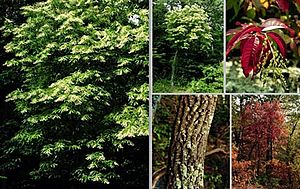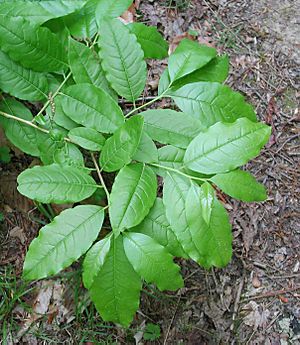Sourwood facts for kids
Quick facts for kids Sourwood |
|
|---|---|
 |
|
| Conservation status | |
| Scientific classification | |
| Genus: |
Oxydendrum
|
| Species: |
arboreum
|
 |
|
The sourwood (also known as the sorrel tree) is a special kind of tree. Its scientific name is Oxydendrum arboreum. It is the only type of tree in its group, called Oxydendrum, and it belongs to the plant family Ericaceae.
You can find sourwood trees naturally in eastern North America. They grow from southern Pennsylvania all the way down to northwest Florida, and west to southern Illinois. They are most common in the lower parts of the Appalachian Mountains. These trees often grow in forests where oak trees and heath plants are also found.
Contents
What Does a Sourwood Tree Look Like?
Sourwood trees are usually small trees or large shrubs. They typically grow about 10 to 20 meters (33 to 66 feet) tall. Their main trunk can be up to 50 centimeters (20 inches) wide. Sometimes, in very good growing spots, they can even reach over 30 meters (98 feet) tall and 60 centimeters (24 inches) wide!
Leaves and Colors
The leaves of the sourwood tree grow one after another along the branch. They fall off in the autumn, which means they are deciduous. Each leaf is about 8 to 20 centimeters (3 to 8 inches) long and 4 to 9 centimeters (1.5 to 3.5 inches) wide. They have slightly jagged edges, like tiny teeth. In summer, the leaves are a dark green color. But in the fall, they turn a beautiful, bright red!
Flowers and Fruit
Sourwood trees have white, bell-shaped flowers. Each flower is small, about 6 to 9 millimeters (1/4 to 1/3 inch) long. These flowers grow in long clusters called panicles, which can be 15 to 25 centimeters (6 to 10 inches) long. After the flowers, the tree produces small, woody capsules that hold the seeds.
Roots and Soil Needs
The roots of the sourwood tree do not go very deep into the ground. The tree grows best when there isn't too much competition from other plant roots nearby. It also needs acidic soil to grow well.
Sourwood Tree Details
The bark of the sourwood tree is gray with a hint of red. It has deep grooves and looks scaly. When the branches are new, they are light yellow-green, but they later turn reddish-brown. The wood inside is reddish-brown with lighter sapwood. It is heavy, hard, and has a fine grain, which means it can be polished to a nice shine.
Winter Buds
In winter, the tree has tiny, dark red buds that are partly hidden in the bark. These buds are found where the leaves meet the stem. When spring comes, the inner parts of these buds get bigger as new growth begins.
Leaf Shape and Veins
Sourwood leaves are arranged alternately on the stem. They are typically 4 to 7 inches long and 1.5 to 2.5 inches wide. Their shape is like a long oval, wider at the top and narrow at the base. They have jagged edges and a pointed tip. The veins in the leaves look like feathers, with a clear main vein down the middle. When they first appear, the leaves are bronze-green and shiny. As they grow, they become dark green and shiny on top, and lighter underneath. In autumn, they turn a bright scarlet red. The stems that connect the leaves to the branch are long and thin. The leaves are known for being quite acidic.
Flowers Up Close
In June and July, the sourwood tree blooms with creamy-white flowers. These flowers grow in long clusters at the ends of the branches. Each flower has five small, green parts called a calyx at its base. The main part of the flower, the corolla, is shaped like an oval tube and is cream-white with five small teeth. Inside the flower, there are 10 stamens (which produce pollen) and one pistil (which contains the seeds).
Fruit Details
The fruit of the sourwood tree is a small, five-sided, five-part capsule. It feels a bit fuzzy and has the dried style (part of the pistil) at its tip. The small stems holding the fruits are curved.
Uses of the Sourwood Tree
The sourwood tree is a great ornamental tree for yards and parks because it is strong and can handle cold weather. People like it because its flowers bloom late in the season, and its fall colors are truly beautiful and bright.
Honey and Jelly
Sourwood trees are famous for their nectar, which bees love! Bees use this nectar to make a special kind of honey called sourwood honey. This honey is very popular. The juice from the flowers can also be used to make sourwood jelly.
Traditional Uses
Long ago, the Cherokee and Catawba Native American tribes used the young shoots (new branches) from sourwood trees to make arrowshafts. The leaves are also known to be a mild laxative.
Sourwood in Culture
There is a well-known old-time song in the Appalachian region of the United States called "Sourwood Mountain".
Images for kids
-
Sourwood in autumn foliage on top of Pilot Mtn., NC. (10-30-2008)
See also
 In Spanish: Oxidendro para niños
In Spanish: Oxidendro para niños





